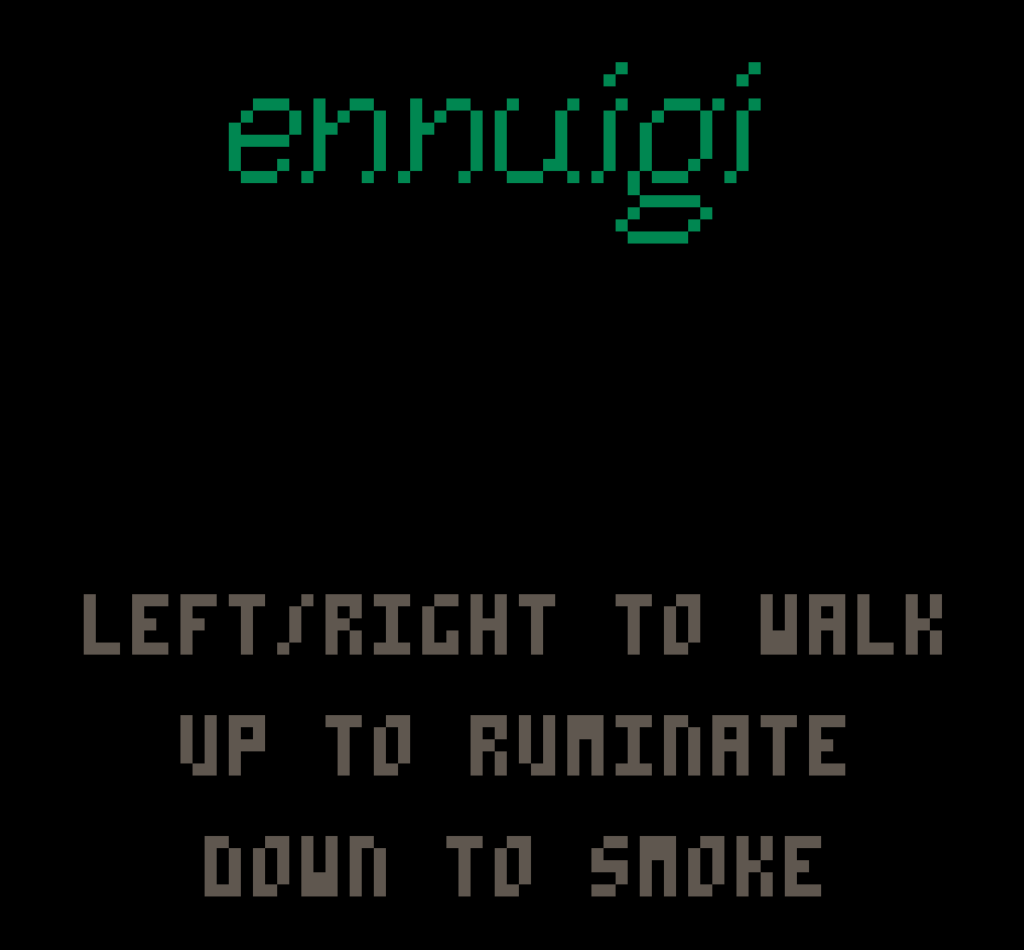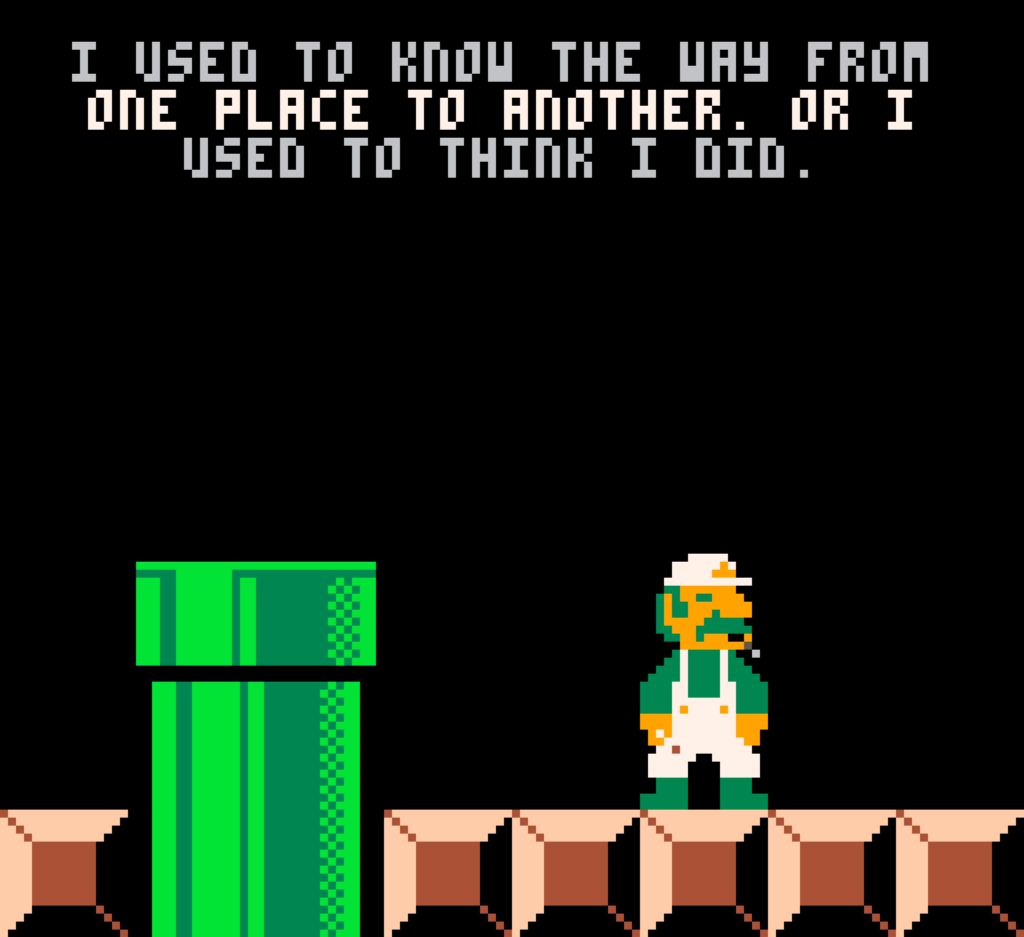
This one’s actually playable! Josh Millard, cortex on Metafilter, some time back made a cute little Pico-8 game in which Luigi wanders a decaying Mushroom Kingdom having depressive thoughts.

Here is some video:
Ennuigi (lexaloffle.com)
The Flipside of Gaming

This one’s actually playable! Josh Millard, cortex on Metafilter, some time back made a cute little Pico-8 game in which Luigi wanders a decaying Mushroom Kingdom having depressive thoughts.

Here is some video:
Ennuigi (lexaloffle.com)
Romhack Thursdays still on break. In the meantime this video from People Make Games tells us about Excel ESports, a thing that is real enough that it was on ESPN last year.
This is another huge topic that I should come back to later, but in the meantime here’s an article, mostly about the British type-in scene, from Wireframe Magazinne last year. It mentions the longest type-in game ever, Axys: The Last Battle (Youtube), an Amstrad program that had to be printed in five successive issues, and what it calls the best type-in game of all, Crossroads from COMPUTE!, although I’m dubious about that claim, there were lots of type-ins. It’s definitely great, though. It’s worth a read if you have the time, although who has enough of that these days?
The Rise and Fall of Type-In Games Listings (Wireframe)
We’re back with more store pages to review on Indie Inquiries. If you would like us to review your store page in the future, please reach out.
0:00 Intro
1:37 Capsule/Thumbnail
4:47 Trailer
10:03 Screenshots
12:45 About this Game
18:53 The Title Card
21:08 Final Grade and Outro

Owner of Game Wisdom with more than a decade of experience writing and talking about game design and the industry. I’m also the author of the “Game Design Deep Dive” series and “20 Essential Games to Study”

On Romhack Thursdays, we bring you interesting finds from the world of game modifications.
Edit the Frog is back, with a new romhack! And this one’s really amazing.
We’ve mentioned before Vitor Vilela’s hacks that retro a SA-1 (“Super Accelerator”) into SNES games that suffered from slowdown. So far he’s done it with five games: Super Mario World, Gradius III (which really needed it), Contra III: The Alien Wars and Super R-Type. The fifth is the most amazing so far: Race Drivin’.
When the original Hard Drivin’ came to arcades it was pretty incredible, the first 3D racing game that didn’t use scanline tricks to display its track, that rendered it using an actual polygonal 3D engine. It used special custom hardware to make its track and physics possible. Race Drivin’ was less revolutionary, but only because the ground had been broken for it.
It was exactly the worst kind of game to be ported to the Super Nintendo’s infamously underpowered hardware, a 16-bit variant of the venerable 6502 running at about 3.5 mHz, just a bit over twice the speed of the NES. Even from the start, the SNES used in-card accelerators and co-processors to help complex games run: even though launch title Pilotwings made heavy use of the SNES’s “mode 7” graphics to display the game world, it still needed a DSP chip to help it with calculation.
https://github.com/VitorVilela7/SA1-Root/tree/master/Race-DrivinRace Drivin’ doesn’t use any accelerator, despite being one of the games most sorely in need of one. Asking a SNES to perform up to the custom mathbox chips in the arcade game was ludicrous, and so SNES Race Drivin’ is looked down upon by many, and probably unjustly: the coding is perfectly all right, it was just asking too much of the system.
Even with a SA-1 you’d think that Race Drivin’ on SNES couldn’t measure up, but Vitor’s hack does quite a respectable job! The SA-1 is essentially a second of the same kind of chip that runs the SNES, with a number of extra features bundled in. It also has some faster memory included on-die, and runs at triple the frame rate. Imagine if this had come out at the time: the SNES game is less than two years older than the arcade version! An SA-1-powered version that matched the arcade so closely back then would have astounded. I see that in a few places on the Super Stunt Track, it drops to 12 FPS instead of the 30 it holds at elsewhere, but it’s still damn slick.
Here is one of Vitor’s side-by-side comparison videos, demonstrating the old version (on the left) and the upgraded hack (on the right):
SA-1 Root: Race Drivin’ (github)
The SuperGrafx is a failed system that had only five games, only three of which seem to be worth playing. The Sharp X68000 series of high-end personal computers, which were only released in Japan, on the other hand, is probably the popular gaming system Westerners have heard the least about.
As I said yesterday, the X68000 cost three grand, and that was just for the base system. If you thought the NeoGeo was expensive, hah. It’s price was justified in that it was a computer, indeed a workstation, and had a variety of software other than games. But it did still have a lot of games, including some of the best arcade conversions, including excellent ports of Rygar, After Burner, Strider, Final Fight, Street Fighter II and Detana! Twinbee, and a well-remembered recreation of the original Castlevania up to then-current aural and visual ideals. The X68000 even got conversions of Atari arcade games like Marble Madness, and even KLAX, that would I would have loved to have played back then.
The X68000 also worked a lot like a MS-DOS machine from the time. It ran mostly HUMAN68K as its OS, a DOS clone made by HudsonSoft, although it also had windowing OSes. Despite how it seemed in use though, it used Motorola 680X0-family processors, like original iteration of the Macintosh. But while it has a DOS-style OS, it’s a home computer with a dedicated sprite chip!
At times it feels like this blog is a recap of my gaming-related Youtube explorations, but I have no qualms about it when they’re as excellent as the two I have this time. One is a review of the “pro” version system from four years ago, from someone who went and obtained one:
Three years later, RMC returned with a more thorough exploration of a different machine of the line:
And this one is about emulating it, which is probably the closest most of us will ever come to trying out any of its software:
The final part of my best of next fest February 2023 showcase.
0:00 Intro
00:24 Meet Your Maker
4:24 Rin the Last Child
6:43 Xenonauts 2
9:04 Wantless
11:49 Dark Envoy
14:34 Takara Cards
15:58 Ogu and the Secret Forest
17:55 Enenra
19:23 Pizza Kidd
20:50 CursedSword
22:03 The Last Starship
23:56 Black & White

Owner of Game Wisdom with more than a decade of experience writing and talking about game design and the industry. I’m also the author of the “Game Design Deep Dive” series and “20 Essential Games to Study”
What is the SuperGrafx? Why don’t we remember it as well as its predecessor, the PC Engine/TurboGrafx 16, with which it was backwards compatible?
Sharopolis on Youtube digs into the system and its capabilities (17 minutes):
As you can tell by the video’s cover image: Amazing Power, No games. The SuperGrafx only had five games released for it throughout its lifetime, pretty harsh for a system that cost around $300 by today’s money. That cost, relative to that of the PC Engine CD, which was also expensive but could play CD games with vastly greater storage, was probably what doomed it. For those really seeking an arcade experience in Japan there was the Sharp x68000, famous at the time as the true enthusiast’s system with a good number of nearly exact arcade ports. It also cost around $6,000 in today’s money, and still $3,000 in then-money.
The system used the same chip as the PC Engine before it, a 6502 variant running at 7 mHz, meaning it was only a 8-bit system. But was that really so bad? The major 16-bit competition for it was the Motorola 68000, another venerable chip at the time that was used in the original Apple Mac, the Sega Mega Drive/Genesis, the Commodore Amiga and the Atari ST. Yet the 68000 also had some more overhead. Many instructions on the 6502 completed in from two to four cycles, whereas the minimum cycle count of a 68000 instruction was four, with some taking up to 20. This, of course, is offset by the 68000’s greater number of registers and ability to work with two bytes at once for many instructions.
Its graphics were essentially two of the PC Engine’s graphics chip, with some circuitry to interface their outputs together. This description brings uncomfortable reminders of people deriding the Wii’s graphics as “two Gamecubes taped together,” but it’s a much closer description of the SuperGrafx’s graphics. But in practice this meant twice the sprites, dual-plane backgrounds, and double the potential colors on-screen at once, while the MegaDrive/Genesis infamously was still stuck with 64.
The SuperGrafx’s failure in the market was one of those inflection points of the growth of video gaming. If it had succeeded then NEC might still be a player in gaming today, and maybe Hudson Soft would still be an independent entity, instead of just another property for Konami to mine for nostalgiabucks.
Indie Games Plus’s Joel Couture, who’s kind of a friend of the blog, reviewed this silly exploratory platformer/horror game/dating sim. They admit that they’re running a campaign to promote it, but that it doesn’t affect their review. I believe them, because the premise is way too ridiculous and charming to pass up. I can assure you that I have no connection with them! It’s on the PS Store, the Xbox Store (if that’s what it’s called, I’m fuzzy on it), the Epic Store, and Steam, which is a store but doesn’t include the word store in its name. They say It’ll be in the Switch eStore eShop later on.

You can choose to play either a male or female Dracula. I don’t see signs of a gender ambiguous version, but we are talking about a vampire here, they’re kind of notorious in popular culture for not caring a lot about what their partner’s sex or gender is. There’s 12 monsters across two genders and lots of species. Hey, it’s got Cthulhu in a dress!

Admittedly there’s lots of games that don’t live up to a great premise. The memory of the $4 I wasted on Animal Fight Club still sticks in my craw. The Steam reviews are mostly positive, with some people complaining of jank and some implementation issues, so you should know about that going in. But it’s only been out a week so far, so it’s likely to improve in the coming months. It’s up to you if you want to jump the gun now or wait to see if it gets better, but its presentation is charming already, tastefully sexy and playful without being raunchy. I can appreciate that!
Romancelvania (Indie Games Plus review – PS – Xbox – Epic – Steam)